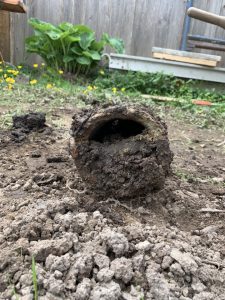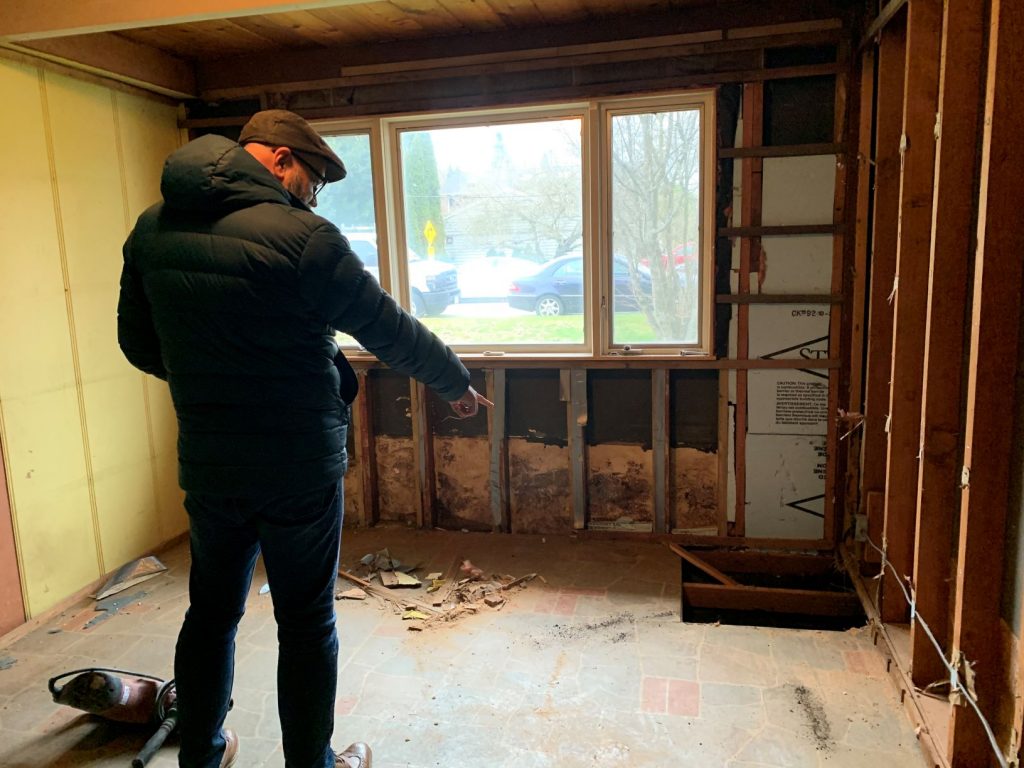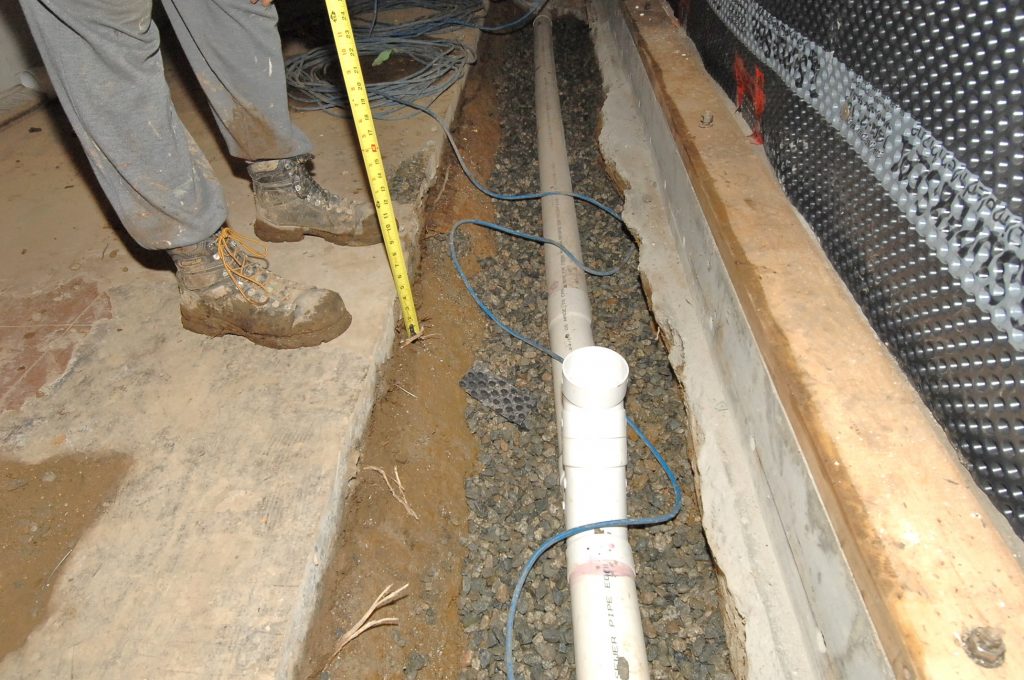Common Drainage issues in homes
While liquid sunshine and hilly terrain make the North Shore glorious and green, it can be bad news for your home and garden. As many homeowners discovered during last winter’s relentless rainy season, non-stop downpours can lead to serious drainage problems and hefty repair bills. Symptoms may be obvious such as puddles in your garden that fail to drain after a big storm or pooling water at the foundation of your home that seeps into your basement. Sometimes it isn’t as obvious, you may be putting in a new patio and uncover a larger need as you begin to reveal your current drain tile system and see that it was poorly designed in the first place. But it is not just poor construction that is the issue, time and regular use can be the challenge as well. The early tell-tale signs may be easy to ignore as they cause a little inconvenience but turning a blind eye and crossing your fingers will only lead to an escalating set of problems and bigger bills.
The Top 3 Causes Of Drainage Issues
- Poor drainage system design, or lack of one
- Lack of drainage maintenance over time
- Limited space between houses
In some cases, these challenges come up as part of a larger home renovation or a new home build, but they can also come up at any time, including as part of an annual review of your home maintenance. Many homeowners notice issues just after winter as the nicer days begin to get longer, and we spend more time outside in the garden and begin planting for the spring and summer seasons.
Let’s take a deeper look into the common causes of drainage issues:
1. Poor Drainage System Design
Water is the biggest problem with residential buildings, and too many homes have been built with poor drainage systems and water that should run off into storm sewers ends up percolating down to the concrete foundations. When we visit someone’s house, drainage defects are often the first thing we spot. The driveway will be cracked, and the concrete stairway has sunk and come off its footing. Both are signs that the drainage tile is out of whack. If you have a driveway that slopes down to your garage and there is no drain to collect and channel the rainwater, it will come right into your basement and eventually start crumbling the concrete. These types of drainage design issues can be seen in new and older homes.
- The worst-case scenario is a house that sinks because it was built on loose soil without drainage gravel.
- As water seeps through the ground, it will take the route of least resistance.
- A clay or hardpan base is much less of an issue, but loose soil can get washed away under the foundations.
- And over time, flowing water creates cavities that can destabilize a house.
We have seen 10ft cavities below the footpath of a house caused by water that had nowhere to drain and, as a result, had to re-building the foundation as a result. The house had sunk three inches, and the window frames were so warped that every time the owners replaced the windows, they buckled. The house had to be lifted, and we re-poured the foundations. This is an extreme example of what can happen, but unfortunately, it is not so unusual with our combination of mountains and heavy rain.
2. Lack of Drainage Maintenance
In a wet climate like we see in the Metro Vancouver area, the “Raincouver” experience is part of life. In many cases, homeowners don’t realize the frequency of maintenance required to keep a home watertight and avoid unwanted issues because they miss the signs or don’t connect the dots between issues within their home what is happening outside of their home to the garden or laneway. Not meaning to cause harm to their home, lack of regular maintenance can cause larger issues down the road. Our Upward Spring Drainage Checklist allows homeowners to review their homes annually for any challenges to avoid any costly issues down the road.
Blocked Drain Tiles
Poor maintenance of home drainage systems is common on the North Shore because many people don’t know that they need to take care of their drainage systems. In older houses, in particular, drainage tiles were not designed to last a lifetime, and they get clogged over time, as we see in the image below.

In a recent large renovation project in North Vancouver, the owner decided that they wanted a new outdoor patio at grade level. By digging out their existing drain tile system to tie into our new patio location, we uncovered blocked concrete drain tile that hadn’t been found could have been costly for the homeowner shortly thereafter. As it was, the blockage was approximately 75% blocked with mud and very brittle, and over the years, it hadn’t been replaced over time as part of regular long-term maintenance. An additional unforeseen cost in their overall budget but less costly to add into their renovation project then hire a team later.

Common symptoms of poor maintenance of your draintile
With the return of wetter weather, keep an eye out for any potential drainage problems that can be fixed before it’s too late. Even after a big rainstorm, water should drain away easily.
- If you are left with a big puddle on your lawn that takes days to dissipate, you have a problem.
- Boggy areas around your property are another sign that you need to sort out the drainage tile.
- Poor plant growth in otherwise ideal surroundings is a symptom of drainage issues. As well as damaging the foundations of the house, the plants in your garden will not thrive if they have soggy roots for nine months of the year.
- Mouldy smells in the basement. Constant dampness will create ugly mould patches on your walls. And if you have traditional forced-air heating ducts, the mould will be hard to contain as spores are sucked into the vents and circulated the house.
In the photo below, we see common water ingress symptoms where water has soaked the exterior cladding and seeped into the wall, causing mould and dampness. This example was tied to other water issues, but the results look the same when viewing the damage done to the home’s interior from water ingress.

3. The location of neighbours home to yours and the impact of limited space between homes
Common in the Vancouver and North Vancouver area, where homes were built post-war to accommodate growing families and building density, created homes with less than six feet between houses. Depending on where your home is situated, you may be very close to your neighbour, and alternative options to drainage are needed, as we see in this case below where we opted for in-slab drainage. An in-slab drainage system is an option if you have less space between your home and your neighbour’s home.

These issues are often associated with older homes, but even some new homes are built with inadequate drainage. If the runoff is coming downhill directly onto your home or trickling away from your neighbour’s property, check that it drains at least 20ft away from your property. If you do notice these problems, don’t wait to get them sorted out. It is often surprisingly straightforward to fix, and the cure is almost immediate. We’ve taken a property that’s a foot deep in a bog, and within a week, it was as dry as a bone – all because of new drainage tiles. Compared to the cost of lifting a house, a ring of drainage tiles is a much cheaper option. Problem-solving for drainage issues requires an experienced construction team and a company that guarantees their work. Our process for managing projects allows us to understand the root causes of issues better to support better your plans to improve your home.
Download our Spring Drainage Checklist and take a tour around your property. Identify any areas of concern and note them down as part of your home maintenance records. We are happy to come and look to give an evaluation for free and share some common solutions for your issues.

For some supplemental reading, the City of Vancouver offers drainage repair tips for homeowners, given the climate supporting homeowners navigate this issue.
Want to know more about us? We are a group of dedicated building professionals with years of experience working in North Vancouver, West Vancouver, Vancouver and Whistler. Better Business Bureau Accredited, we are proud of our A+ rating and 5* ratings on Google. We specialize in remediation of drainage issues, laneway home builds, full home renovations, and contemporary home builds that meet green building standards through the BuiltGreen Canada sustainability standards, meet the Upward Team.
Have a project in mind? Contact us today, and we’d be happy to connect.

